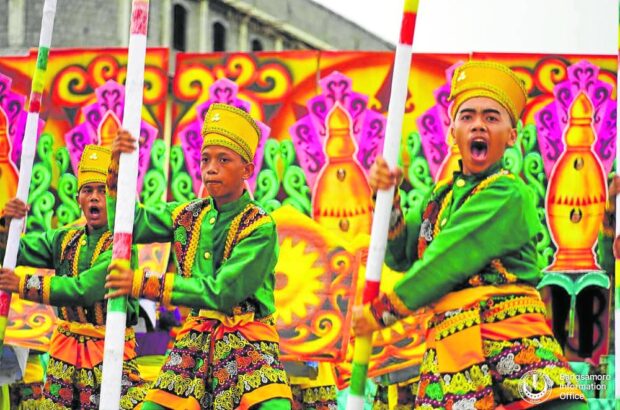
PASSING ON HERITAGE Bangsamoro youth perform traditional dances (above and bottom left) during the “Kuyog” street dancing competition as part of the Shariff Kabunsuan Festival that sought to pass on to the next generation a rich cultural heritage. —PHOTOS COURTESY OF THE BANGSAMORO INFORMATION OFFICE
COTABATO CITY — As sunlight shone on the Rio Grande de Mindanao on Dec. 19, a resplendent display was created among some 94 colorful decorated boats waiting for the start of the annual fluvial parade called “Guinakit.”
Thousands of people waited along the riverbanks to witness the seeming parade of Bangsamoro colors as the contingents coming from the six provinces of the Bangsamoro Autonomous Region in Muslim Mindanao (BARMM) embellish their boats with native textiles, the production of which is part of their communities’ centuries-long tradition.
People applauded as the garish vessels made their way upstream to Barangay Poblacion 4 where the old Cotabato seaport sits, then downstream to Barangay Kalanganan 2 where the Arab-Malay missionary Shariff Kabunsuan was thought to have disembarked after a long journey across the seas.
Guinakit, which means “a convoy of boats,” is staged every year to reenact the arrival of the Johor-born Kabunsuan in mainland Mindanao about five centuries ago. Bangsamoro history attributes to Kabunsuan the spread of Islam in the region as well as the founding of the Sultanate of Maguindanao.
The fluvial parade also capped a weeklong festival organized by the BARMM government in honor of Kabunsuan that highlighted, among others, the various dance as well as culinary traditions of the region of 4.9 million people.
This year, Guinakit adopted the theme, “Honoring Traditions, Forging New Horizons.”
EXPLOSION OF COLORS A splendor of colors identified with the Bangsamoro tribes are on display through the ornate boats taking part in the “Guinakit” on Dec. 19. —PHOTOS COURTESY OF THE BANGSAMORO INFORMATION OFFICE
Preacher, leader
BARMM Chief Minister Ahod “Al Haj Murad” Ebrahim described Kabunsuan as a determined preacher and leader whose dominion as sultan encompassed the central valley of Cotabato, the flooded plains of Maguindanao, and the mountains of Lanao.
“His arrival not only marked the establishment of a new form of government but also laid the foundation for our distinctive identity and faith as Muslims and Bangsamoro in the Philippines. May we be continually inspired to emulate his spirit of determination, resilience, and commitment to the betterment of our community,” Ebrahim said.
“Embracing the ever-changing world, we can shape our aspirations and like him, be pioneers of progress, ensuring the vibrancy and relevance of our culture and traditions in the global landscape,” he added.
“Let us forge new paths, ensuring that our culture and traditions remain dynamic and relevant in the ever-evolving world. Just as Shariff Kabunsuan sailed toward new horizons, let us continue to build a future that reflects the values he championed—a future where the Bangsamoro people flourish, guided by the principles of unity, faith, and cultural richness,” said Ebrahim, a former revolutionary with the Moro Islamic Liberation Front who was thrust into political leadership in the BARMM after his group forged a peace deal with the government in 2014.
In an effort to enliven its own narrative as a people, the BARMM government created the Bangsamoro Commission for the Preservation of Cultural Heritage, further strengthening previous efforts.
During the “Kuyog” street dancing competition that showcased traditional dances, Cotabato City Mayor Mohammad Ali Matabalao urged the people “to preserve and pass on the community’s cultural heritage to the coming generations” even as he committed to sustain the tilt “to serve as an anchor [and] reminding the Bangsamoro people of their roots.”
“The dancers’ graceful movements, vibrant costumes, and the infectious beats of the music are not just entertainment but a powerful expression of our identity and values,” Matabalao pointed out.
MASTER AT WORK Sama igal master Sakinur-ain Mugong Delasas (right) rehearses moves for the traditional dance with Nursida Nurullaji in Bongao, Tawi-Tawi. —PHOTO FROM FACEBOOK
PAGE OF SAKINUR-AIN DELASAS
Multicultural heritage
Bangsamoro traditions occupy a big part of the country’s multicultural heritage. In fact, six of the 25 awardees of the prestigious Gawad sa Manlilikha ng Bayan or National Living Treasures are from the region.
The latest to have joined this elite group of cultural icons is Sakinur-ain Mugong Delasas, a Sama master of traditional dance, from Bongao, Tawi-Tawi. She is recognized for her commitment to preserving the Sama “igal” (dance) tradition.
Others before her were Samaon Sulaiman of Maguindanao, for music through playing “kutyapi,” a two-stringed instrument; Uwang Ahadas of Basilan for Yakan music through playing the “kulintang,” “kwitangan kayu,” “gabbang,” “agung” and “tuntungan,” all traditional percussions; Darhata Sawabi, weaver of Tausug textile Pis Syabit from Sulu; Haja Amina Appi, a Sama mat weaver from Tawi-Tawi; and Ambalang Ausalin, master weaver of Yakan “tennun” from Basilan.
READ: Hundreds in Cebu watch fluvial procession of Fiesta Señor 2023